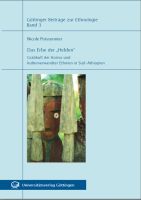Das Erbe der „Helden“
Grabkult der Konso und kulturverwandter Ethnien in Süd-Äthiopien
Author(s)
Poissonnier, Nicole
Collection
AG UniversitätsverlageLanguage
GermanAbstract
The work offers for the first time a comprehensive study of the anthropomorphic wooden sculptures of the Konso (waakaa) with a detailed description of the figures, their production, their symbolism, the way they are erected and associated rituals. Based on an inventory, the figures are divided into three different categories: the waakaa as a group of figures forming a memorial to a man who killed an enemy or a defensible animal, as a memorial to people who excelled in other ways, and as a grave marker for anyone who was married and had children. The study places the waakaa comparatively in the overall regional and historical context of stelae and other monuments in Ethiopia, many of which are monuments to deceased "hero killers". The waakaa of the Konso are therefore considered in the focus of the very widespread "killing practice" in earlier years. The examination of the preparations, regulations and rituals to be followed in connection with the killing makes it clear that this is a liminal rite through which a man changes to a new social status. A second focus is the connection of the waakaa with the funeral ceremonies on the occasion of which they are erected, which are particularly elaborate for "heroic slayers". In many cases, the erection of the monument is made dependent on the existence of a descendant. The size and elaborateness of the monument can in turn be used to infer the numerical size or economic position of the descendants. In this way, the kinship group can demonstrate its own strength through the elaborateness of the festivals and monuments. The number of monuments accumulated over the years thus becomes a visible symbol of the group's strength and fortitude. The analysis of these two aspects leads to the connection, already considered by previous researchers, between the act of killing by the man and his ability to beget new life. This connection is seen in terms of the concept, widespread in southern Ethiopia, of a circulating vitality that can be enriched in this way. Die Arbeit bietet erstmals eine flächendeckende Studie der anthropomorphen Holzskulpturen der Konso (waakaa) mit einer detaillierten Beschreibung der Figuren, deren Herstellung, ihrer Symbolik, der Art und Weise ihrer Aufrichtung und dazugehöriger Rituale. Auf der Grundlage einer Inventur werden die Figuren in drei verschiedene Kategorien unterteilt: die waakaa als Figurengruppe, die ein Denkmal für einen Mann bildet, der einen Feind oder ein wehrhaftes Tier getötet hat, als Denkmal für Menschen, die auf andere Weise Herausragendes geleistet haben, und als Grabmarkierung für jeden Menschen, der verheiratet war und Kinder bekommen hat. Die Studie ordnet die waakaa vergleichend in den regionalen und historischen Gesamtkontext der Stelen und anderer Monumente in Äthiopien ein, die zu einem groβen Teil Denkmäler für verstorbene „Heldentöter“ sind. Die waakaa der Konso werden daher im Fokus des in früheren Jahren sehr weit verbreiteten „Töterwesens“ betrachtet. Die Untersuchung der mit dem Töten verbundenen Vor- und auch Nachbereitungen, Reglementierungen und zu befolgenden Rituale verdeutlicht, dass es sich hierbei um einen Liminalritus handelt, durch den ein Mann in einen neuen gesellschaftlichen Status wechselt. Einen zweiten Fokus bildet die Verbindung der waakaa mit den Totenfeiern, anlässlich derer sie aufgestellt werden, und die für „Heldentöter“ besonders aufwendig gestaltet sind. In vielen Fällen wird die Errichtung des Denkmals von der Existenz einer Nachkommenschaft abhängig gemacht. Von der Größe und Aufwendigkeit des Denkmals kann wiederum auf die zahlenmäßige Größe bzw. wirtschaftliche Position der Nachkommenschaft geschlossen werden. Dadurch kann die Verwandtschaftsgruppe durch die Aufwendigkeit der Feste und Monumente ihre eigene Stärke demonstrieren. Die sich über die Jahre ansammelnde Anzahl der Monumente wird so zu einem sichtbaren Symbol der Stärke und Wehrhaftigkeit der Gruppe. Die Analyse dieser beiden Aspekte führt zu der von früheren Forschern bereits betrachteten Verbindung zwischen dem Akt des Tötens durch den Mann und seiner Fähigkeit, neues Leben zu zeugen. Dieser Zusammenhang wird anhand des in Süd-Äthiopien weit verbreiteten Konzepts einer sich im Kreislauf befindenden Vitalität gesehen, die auf diese Weise angereichert werden kann.
Keywords
ethnology; burial rites; South Ethiopia; Fruchtbarkeit; Jagd; Konso (Volk); Löwen; Stele; WakaDOI
10.17875/gup2009-419ISBN
9783941875036OCN
924729016Publisher
Universitätsverlag GöttingenPublication date and place
2009Classification
Social and cultural history
Society and Social Sciences


 Download
Download Web Shop
Web Shop